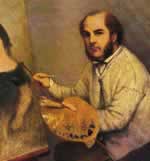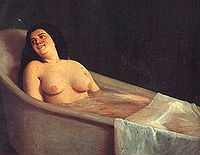
Prilidiano Pueyrredón
Encyclopedia

Argentina
Argentina , officially the Argentine Republic , is the second largest country in South America by land area, after Brazil. It is constituted as a federation of 23 provinces and an autonomous city, Buenos Aires...
painter, architect, and engineer. As one of the country's first prominent painters, he was known for his costumbrist sensibility and preference for everyday themes.
Early life
Pueyrredón was the only son of Juan Martín de PueyrredónJuan Martín de Pueyrredón
Juan Martín de Pueyrredón y O'Dogan was an Argentine general and politician of the early 19th century. He was appointed Supreme Director of the United Provinces of the Río de la Plata after the Argentine Declaration of Independence.-Early life:Pueyrredón was born in Buenos Aires, the fifth of...
, then the Supreme Director of the United Provinces of the Río de la Plata
Supreme Director of the United Provinces of the Río de la Plata
The Supreme Director of the United Provinces of the Río de la Plata , was a title given to the executive officers of the United Provinces of the Río de la Plata, according to the form of government established in 1814 by the Asamblea del Año XIII...
, and María Calixta Tellechea y Caviedes, an aristocrat. He completed his primary education at the upper-class Colegio de la Independencia. In 1835 his family relocated to Europe, where he completed his education. He spent the school year in Paris
Paris
Paris is the capital and largest city in France, situated on the river Seine, in northern France, at the heart of the Île-de-France region...
and summers in Cádiz
Cádiz
Cadiz is a city and port in southwestern Spain. It is the capital of the homonymous province, one of eight which make up the autonomous community of Andalusia....
, where his father owned a business importing Argentine leather.
Six years later, as relations between France
France
The French Republic , The French Republic , The French Republic , (commonly known as France , is a unitary semi-presidential republic in Western Europe with several overseas territories and islands located on other continents and in the Indian, Pacific, and Atlantic oceans. Metropolitan France...
and Argentina suffered due to the refusal of Juan Manuel de Rosas
Juan Manuel de Rosas
Juan Manuel de Rosas , was an argentine militar and politician, who was elected governor of the province of Buenos Aires in 1829 to 1835, and then of the Argentine Confederation from 1835 until 1852...
to grant commercial privileges to ships of French origin — a matter which would not be resolved until the Battle of Vuelta de Obligado
Battle of Vuelta de Obligado
The naval Battle of Vuelta de Obligado took place on the waters of the Paraná River on November 20, 1845, between the Argentine Confederation, under the leadership of Juan Manuel de Rosas, and an Anglo-French fleet.- Background :...
a few years later — , the Pueyrredóns left Europe for Río de Janeiro
Rio de Janeiro
Rio de Janeiro , commonly referred to simply as Rio, is the capital city of the State of Rio de Janeiro, the second largest city of Brazil, and the third largest metropolitan area and agglomeration in South America, boasting approximately 6.3 million people within the city proper, making it the 6th...
. The city's liberal atmosphere encouraged Pueyrredón's artistic vocation. On his return to Paris three years later he received his parents' permission to study engineering.
Return to Buenos Aires

San Isidro, Buenos Aires
San Isidro, Buenos Aires is a municipality in Greater Buenos Aires and one of the most affluent municipalities in Argentina. It is located in San Isidro Partido in the Buenos Aires Province....
. Although the young Prilidiano, already an engineer, was a peculiar figure by the standards of the Porteño aristocracy, and although rumours abounded about his immorality — he was the first painter in Buenos Aires to paint nudes, of which two, La siesta and El baño, survive to this day and are housed in the Museo Nacional de Bellas Artes
Museo Nacional de Bellas Artes (Buenos Aires)
The National Museum of Fine Arts is an Argentine art museum in Buenos Aires, located in the Recoleta section of the city. The MNBA inaugurated a branch in Neuquén in 2004.-History:...
— he managed to gain favour with the aristocracy by painting their portraits. His subjects included Manuelita, the daughter of Rosas, whom he painted in 1851, shortly before the caudillo's defeat
Battle of Caseros
The Battle of Caseros was fought near the town of Caseros, more precisely between the present-day train stations of Caseros and Palomar in Buenos Aires Province, Argentina, on 3 February 1852, between the Army of Buenos Aires commanded by Juan Manuel de Rosas...
.
In the middle of that year, however, he fell out with his cousin and neighbour Magdalena Costa, whom he had courted, and this drove him to leave the city and return temporarily to Cádiz. Here, an affair with a local girl led to the birth of his only daughter.
Artistic maturity
.jpg)
Argentine Confederation
The Argentine Confederation is one of the official names of Argentina, according to the Argentine Constitution, Article 35...
, had embarked upon. He worked on the restoration and enlargement of various monuments, among them the chapel of Recoleta
La Recoleta Cemetery
La Recoleta Cemetery is a famous cemetery located in the exclusive Recoleta neighbourhood of Buenos Aires, Argentina. It contains the graves of notable people, including Eva Perón, Raúl Alfonsín, and several presidents of Argentina.- History :...
, the Pyramid
Pirámide de Mayo
The Pirámide de Mayo , located in the center of the Plaza de Mayo, is the oldest national monument in the City of Buenos Aires. Its construction was ordered in 1811 by the Primera Junta to celebrate the first anniversary of the May Revolution. It was renovated in 1856, under the direction of...
of the Plaza de Mayo
Plaza de Mayo
The Plaza de Mayo is the main square in downtown Buenos Aires, Argentina. It is flanked by Hipólito Yrigoyen, Balcarce, Rivadavia and Bolívar streets....
, and the Casa Rosada
Casa Rosada
La Casa Rosada is the official seat of the executive branch of the government of Argentina, and of the offices of the President. The President normally lives at the Quinta de Olivos, a compound in Olivos, Buenos Aires Province. Its characteristic color is pink, and is considered one of the most...
. As an urban planner, he designed the Plaza de la Victoria, a park on what was then the Julio Avenue, and the bridge in the neighborhood of Barracas. He designed the mansion built by Miguel de Azcuénaga
Miguel de Azcuénaga
Miguel de Azcuénaga was an Argentine general who fought for the Province of Buenos Aires.Born in Buenos Aires, he was the son of Vicente de Azcuénaga and Rosa de Basavilvaso. He received an Spanish education in Málaga and Seville...
in Olivos
Olivos, Buenos Aires
Olivos is an Argentine city in Vicente López Partido in the Province of Buenos Aires and a suburb within the Greater Buenos Aires metro area....
which later became the official residence of the President of Argentina
President of Argentina
The President of the Argentine Nation , usually known as the President of Argentina, is the head of state of Argentina. Under the national Constitution, the President is also the chief executive of the federal government and Commander-in-Chief of the armed forces.Through Argentine history, the...
.
The 1850s and 1860s were Pueyrredón's most prolific period as a painter. 233 works survive from this period, more than half of them commissioned portraits. Around the same time, he became one of the first painters to explore the figure of the gaucho
Gaucho
Gaucho is a term commonly used to describe residents of the South American pampas, chacos, or Patagonian grasslands, found principally in parts of Argentina, Uruguay, Southern Chile, and Southern Brazil...
, whom he depicted in the Romantic
Romanticism
Romanticism was an artistic, literary and intellectual movement that originated in the second half of the 18th century in Europe, and gained strength in reaction to the Industrial Revolution...
style he had discovered while living in Europe. Many of his most famous works depict life in the wilds of the Pampas and on the banks of the Río de la Plata
Río de la Plata
The Río de la Plata —sometimes rendered River Plate in British English and the Commonwealth, and occasionally rendered [La] Plata River in other English-speaking countries—is the river and estuary formed by the confluence of the Uruguay River and the Paraná River on the border between Argentina and...
: Un alto en el campo (1861), Capataz y peón de campo (1864), Lavanderas del Bajo Belgrano (1865), and Recorriendo la estancia (1865).


